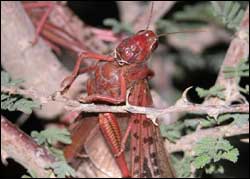Locusts’ Built-In ‘Surface Analysis’ Ability Directs Them to Fly Overland

Closeup of locust in tree. (Photo by Asaph Rivlin)
Swarms of millions of locusts have, since Biblical times and until our very own day, been considered a “plague” of major proportions, with the creatures destroying every growing thing in their path.
Until now, it was thought that the directions of these swarms were predominantly directed by prevailing winds. Now, Hebrew University of Jerusalem scientists have shown that a physiological trait of these grasshoppers – namely their polarization vision — provides them with a built-in source of “surface analysis” – a discovery that could pave the way for efforts to effectively combat this periodic scourge by controlling their natural inclination to fly over land rather than water.
The desert locusts, known scientifically as Schistocerca gregaria, are able to swarm for great distances and in numbers measuring in the millions. During the locust invasion of November 2004 in Israel, it appeared that a swarm came in an easterly direction over Sinai up to the Gulf of Eilat, then turned northward without crossing the water. Only when the swarm reached the northern tip of the gulf did some of them turn again east in the direction of Aqaba and other areas of Jordan, as well as straight north over southern Israel.
This observation led to examination by scientists of the Hebrew University of Jerusalem Department of Evolution, Systematics and Ecology and the Interuniversity Institute for Marine Sciences in Eilat to examine how the locusts were able to identify the gulf water and knew not to fly over it. The research focused on the ability of the locusts to identify polarized light. This is a trait which is lacking in humans but exists among other species, such as fish and insects.
The research was conducted by Dr. Nadav Shashar, who is considered a leading world expert on polarized sight, working with two students, Shai Sabah and Noa Aharoni. The research was published in a recent issue of the journal of the British Royal Society, Biology Letters, as well as in the science news sections of the journals Science and Nature.
“In order to examine if the locusts are using polarized light in determining their flight path, we examined individual locusts’ reactions in situations in which polarized and non-polarized light was reflected from various surfaces. We were able to prove that the locusts avoided flying over areas which were reflecting polarized light — for example from mirrors or plastic surfaces.”
The sea reflects polarized light much more than dry land (which reflects mainly diffused, non-polarized light), enabling a distinction to be made between the two.
“When the locusts are presented with a situation of choice between surfaces reflecting either polarized or diffused light, they exercise their preference to fly over the (dry land) area of diffused light,” said Dr. Shashar. This is a survival instinct, since if they flew over a body of water, the locusts would be deprived of both nourishment and a place to land and rest.
This research, said Dr. Shashar, could be important in providing information that would be useful in developing means for “deceiving” the locusts and deterring them from flying over agricultural lands and causing the great damage that ensues.
One way of doing so might be through more extensive use of plastic sheeting as shields to create the reflection of the polarized light that the locusts avoid.
Media Contact
More Information:
http://www.huji.ac.ilAll latest news from the category: Ecology, The Environment and Conservation
This complex theme deals primarily with interactions between organisms and the environmental factors that impact them, but to a greater extent between individual inanimate environmental factors.
innovations-report offers informative reports and articles on topics such as climate protection, landscape conservation, ecological systems, wildlife and nature parks and ecosystem efficiency and balance.
Newest articles

Properties of new materials for microchips
… can now be measured well. Reseachers of Delft University of Technology demonstrated measuring performance properties of ultrathin silicon membranes. Making ever smaller and more powerful chips requires new ultrathin…

Floating solar’s potential
… to support sustainable development by addressing climate, water, and energy goals holistically. A new study published this week in Nature Energy raises the potential for floating solar photovoltaics (FPV)…

Skyrmions move at record speeds
… a step towards the computing of the future. An international research team led by scientists from the CNRS1 has discovered that the magnetic nanobubbles2 known as skyrmions can be…





















